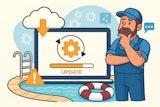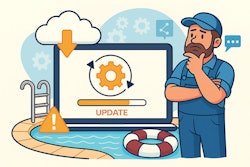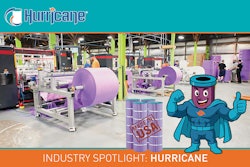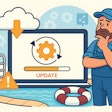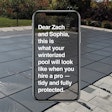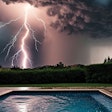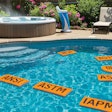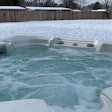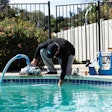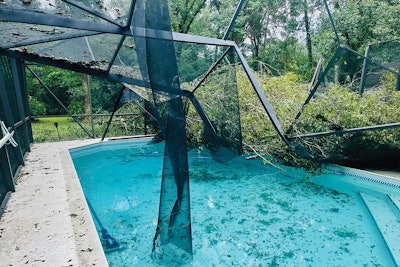
 Rudy Stankowitz is a veteran of both the industry and the U.S. armed forces. He has owned a retail store and done his own research on pool chemistry.
Rudy Stankowitz is a veteran of both the industry and the U.S. armed forces. He has owned a retail store and done his own research on pool chemistry.
It started getting bad somewhere around 8 o'clock at night. I don't know why they always seem to get angry after dark. It adds a different terrifying level when you can't see a thing. We lost power at 9:30 p.m. By 10, the wind was howling, and branches were snapping like firecrackers. Then, at 11:30, there was a horrifically loud, shuddering BOOM.
I pushed out into the gale, armed with only a flashlight, its feeble beam all but lost in the chaos, but providing just enough glow to reveal a 50-foot tree lying across my screen enclosure, and across my pool. Yes, my pool! All I could do was go back inside and hunker back down. So that's what I did.
Days later, I still have that big honking tree across my pool. It's a process that takes time. Thousands of homes were affected, and many were damaged worse than mine. I'm saying this because this is the same situation pool service companies in affected areas will be explaining to their customers, who are frantic about when you'll get to them. You are on the way but without a scheduled date. Every pool will require extra time.
Right now, I'm trying to find a tree company. My insurance claims adjuster says it's okay to move the tree. Great. Now I need the tree company to call me back — I've had to leave messages. I am fine waiting. I'm not impatient.
I know I'm not the only one; many have it much worse. My deductible for hurricane damage is ridiculous. As in ridiculously high.
Under the tree's sheltering boughs, I set two floating chlorinators with trichlor tabs adrift. You gotta do what you gotta do. After a week without the pump running — I'm leaving it off until the tree is gone — the water is still clear, but I'm developing a leafy bottom.
At this point, I may or may not own a boat. It's at the marina in Cedar Key, or at least it was. I haven't heard from anyone there yet. For all I know, it could be in Valdosta. Part of me wants to drive there to see, but I know I'd just be in the way. The little town faced a horrific storm surge. I don't want to gawk at anyone's misfortune, but I'm curious about how the pools in that town look.
 After the storm, the full sun reveals the extent of the damage in fine detail.
After the storm, the full sun reveals the extent of the damage in fine detail.
Emerging to Chaos
In this situation, the situation I'm in, you secure your own life and then go looking for people you can help. Safety is everything when heading into the field after a storm. Storms leave behind dangerous conditions — damaged equipment, downed power lines, roads ending in lakes that look about a foot deep that turn out to be 3 feet deep.
When arriving at a property, you or your tech must assess the area for hazards. Any visible electrical lines down or near the pool or equipment should be reported immediately. NO ONE should work at that house until the utility company confirms the power is safely off or repaired.
Don't send your techs out in Crocs. Consider the PPE (Personal Protective Equipment) they'll need including gloves, boots, and safety glasses. Pools after a storm are often contaminated with floodwater, mud, and debris. They're likely carrying harmful bacteria or hazardous materials. Make sure your techs understand the gravity of the situation.
Since trees often fall during hurricanes (TRUST ME ON THIS ONE!), having a chainsaw is great for getting your vehicle out of your driveway, but at customers' homes, this is outside your service. Leave it to the tree companies; that's their gig, not yours. Your insurance likely won't cover something outside your normal scope. Their insurance will likely cover removing the tree or branch that landed in the pool anyway. Mine does, but believe it or not, it doesn't cover the whole tree, just the part that covers the pool and pool deck. I have another 30 feet beyond that to the trunk that's all mine. Ugh.
For those working along the coast, storm cleanup is another level. For additional guidance, see "Dealing With a Storm Surge" in AQUA Magazine. When sending your team into the aftermath, sensitivity is vital. They'll likely encounter upset homeowners, and you will be dealing with people who feel like they are being jerked around in every which direction, so remind your techs that they don't need to be counselors, but a little understanding goes a long way.
After storms, assessment is critical, even more important than usual. Teach your techs to assess and document the pool and its surroundings. It serves several purposes. It helps you plan your resources, it creates a clear record for the customer, and it's essential evidence for insurance claims.
Photos should be taken from multiple angles to capture everything — the pool, any fallen trees, yard debris, and possible structural damage to the deck, pool, or equipment. Remember, I'm a pool guy, dammit, not Jake from State Farm. So, have your client contact their insurance company to determine what they need and want before you start.
Proper documentation saves time and ensures smooth processing of insurance claims. Keep a copy of these photos for potential disputes later on. If the pool equipment is submerged or damaged, document that before beginning work. You may need to sign an affidavit supplied by the insurance company.
Once the pool area is safe and the assessment is complete, remove large debris from the pool and deck. The storm will have filled the pool with all sorts of schmutz — branches, leaves, giant tree limbs — which can damage the structure or liner if not handled carefully. Especially with vinyl liners, dragging large branches across the bottom can become a big regret.
A leaf net is the best way to remove water debris. Sometimes, I wonder how a cast net would fare. Joking. You'll have to pull large limbs out by hand. Be cautious — debris can conceal dangerous objects like broken glass or sharp metal.
In cases where draining is necessary, abnormally high groundwater levels pose a hazard. Removing too much water could cause the pool to pop out of the ground like a burnt slice of bread from a toaster. Some areas require a contractor's license to remove pool water, so make sure you're covered with the needed credentials and pool "pop- up" insurance.
Suction outlets — main drains, skimmer baskets, and gutter grates — must be thoroughly inspected and cleared of debris. Clogged suction outlets can cause the pump to run dry or cavitate, damaging equipment. After a hurricane, these areas are often clogged with leaves, twigs, or mud.
Scrutinize the equipment. Equipment pads are magnets for hurricane and tornado damage, from electrical failures to structural issues. If there's no visible damage and power is restored, turn
the pool breaker back on and test the system. But if anything looks damaged, it needs to be replaced.
If the pump was submerged, you have to replace it. I don't care what Bob in the Facebook group said. Even if allowed to dry, the insulation inside the motor can be permanently compromised, leading to future failures or safety hazards. Ensure your techs aren't out there rigging temporary fixes — this can cause more damage and create unsafe conditions.
Expect severely unbalanced water due to stormwater contamination. Rebalance the water chemistry once the debris is removed and the equipment is operational. Personally, I'd floc like it's hot. Alum is a fantastic tool for dropping everything — silt, mud, bacteria, phosphates, etc. Just be sure to adjust the pH, temperature, and alkalinity to make it work correctly. Check this article by Dustin Weaver in AQUA Magazine, titled "A New Way to Remove CyA?" (March, 2021 issue) for the process. It deals with lowering CyA, but except for a potentially lighter dose (play it by ear), the steps noted will yield the best results for your storm debris floc.
Once the water is returned to operational levels, superchlorinate it. We're talking about a chlorine dose just shy of napalm. Keep the chlorine at 20 ppm for at least 28 hours with a pH of 7.5 or less. Ideally, you would lower the CyA level to 15 ppm or less to supercharge the chlorine, but I think anyone who drains a pool at this point to get rid of CyA is six beers shy of a six-pack. Without CyA, the same chlorine level must be maintained for about 13 hours.
After superchlorination, run the filter non-stop until the water clears and a chlorine residual is maintained. Depending on contamination, this can take anywhere from a few days to a week. If you are dealing with seawater that somehow sloshed into the pool, keep in mind that it will have a high bromide ion level, creating what seems to be an insatiable chlorine demand. This will take time.
The filter will likely need to be backwashed or cleaned regularly. If you're stretched thin, have the homeowner monitor the pressure gauge and clean the filter when the pressure rises 10 psi above normal (you can't be there daily). Once everything is stable, plan a follow-up visit for a final inspection, ensuring all systems work correctly, and the water is safe to swim in.
Remind your customers to monitor their pools for any post-storm issues. Encourage them to contact you if they notice cloudy water, malfunctioning equipment, or other abnormalities. Specialty chemicals like chelating agents, clarifiers, enzymes, and phosphate removers may come in handy in the weeks following.
 Photos documenting the state of the pool after the storm and before repairs begin are essential.
Photos documenting the state of the pool after the storm and before repairs begin are essential.
Some Customers
Some customers understand. Others, despite the evidence all around them, somehow need to be reminded that the hurricane affected the entire region, not just their backyard — that you have a lot on your plate.
If this is a weekly service account, let them know it might be a few weeks before regular service resumes. Communication is key — call those you haven't yet reached to let them know help is on the way, but without a scheduled day or time.
It's a big job. There are hundreds of thousands of pools that took a blow from Helene. We'll get it cleared one pool at a time.
To everyone else who was in the path of this storm, I hope you and your families made it through safely with minimal loss. Unfortunately, I know that won't be the case for everyone. Some lost homes, cars, pets — and, tragically, some lost loved ones. For those of us in service, it's our job to take care of pools, but in times like these, we look after each other first.
This article first appeared in the November 2024 issue of AQUA Magazine — the top resource for retailers, builders and service pros in the pool and spa industry. Subscriptions to the print magazine are free to all industry professionals. Click here to subscribe.





















